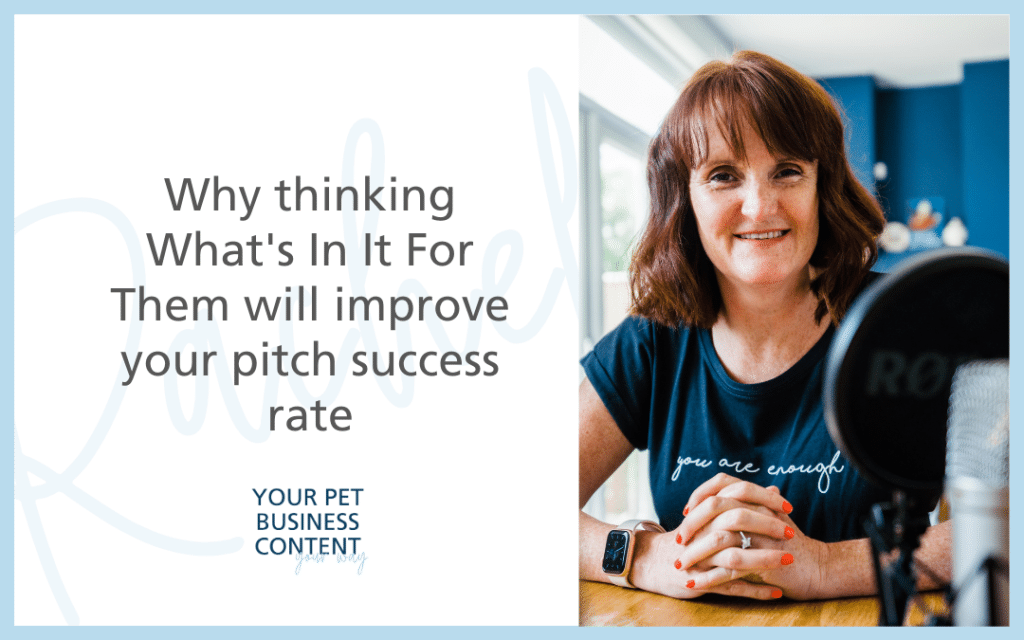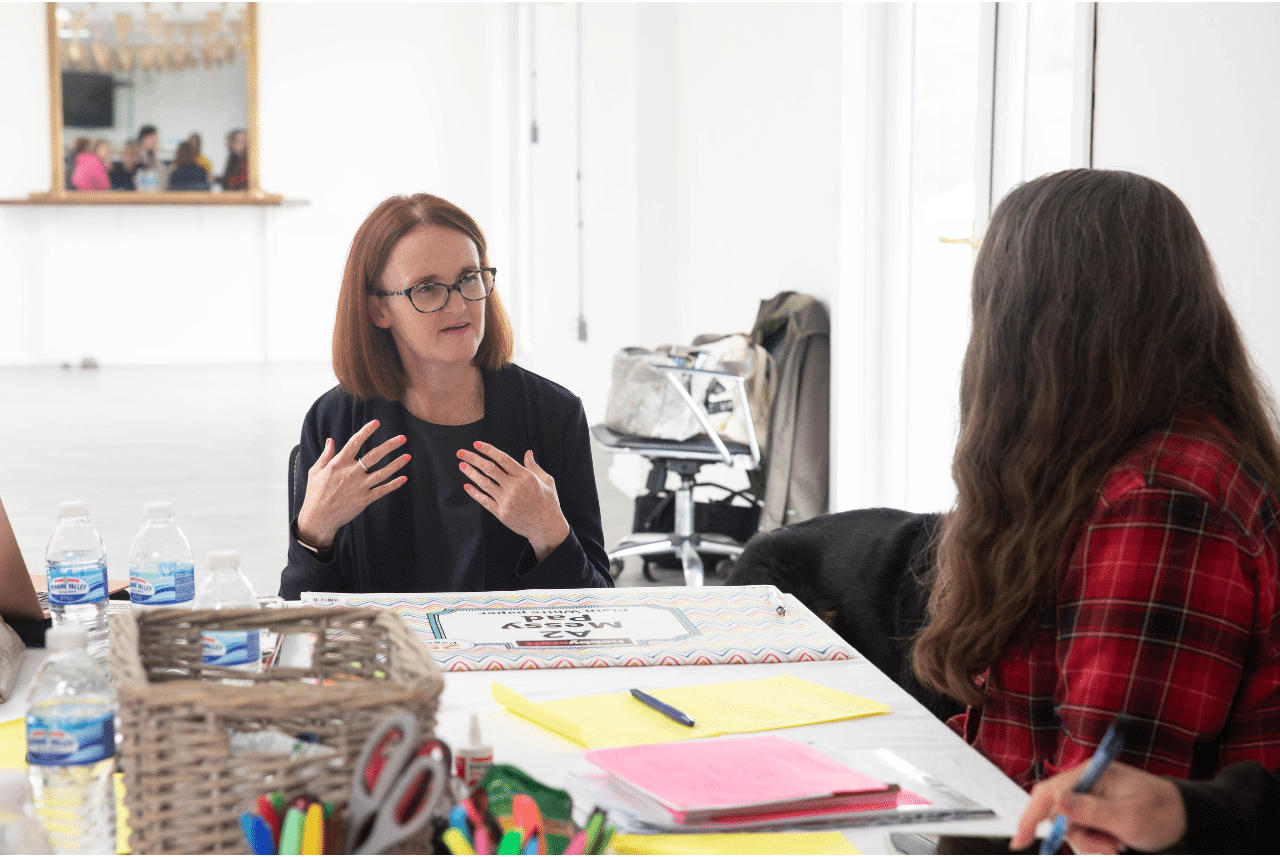In this podcast episode, I’m talking about why thinking ‘What’s in it for them,’ rather than ‘What’s in it for me,’ will drastically improve your pitch success rate.
Are you looking to approach content creators to feature your pet business?
One of the exercises I do with my clients is to ask them to create a ‘wishlist’ of publications where they’d like to be published.
Regularly, people will get in touch and say, ‘I want to be in this magazine or on this podcast or work with this blogger.’
It might be a brand they’d love to collaborate with and they want to know the best way to approach it.
And the key to success is to think, ‘What’s in it for them?’ What is in it for the journalist, content creator or brand in featuring or working with you?
In this episode you’ll learn how ‘What’s in it for them’ works as a pitching approach, and how you can use it to improve your success rate.
Listen in on the player link below or you can read the key points covered in this blog post.
Why I delete most of the pitches I receive
Unless they’re from someone I already know or who I’m currently working with, most of the pitches I get as a podcaster and blogger go in the bin.
This might sound harsh, but it’s because 99% of the people who send them have taken no interest whatsoever in what I do.
I get pitches talking about Daisy, my dog who died six years ago, for my pet blog. For this podcast, people ask to talk about bitcoin and taxis, not even pet ones.
They don’t follow me on social media, aren’t on my newsletter list and haven’t made any effort to build a relationship.
What they offer is of no relevance for my audience and I’d say 80% don’t even use my name in the outreach email.
I have pitches about ‘guest posts’ and link exchanges when I’m made it very clear in my ‘work with me’ page I don’t accept them.
Regularly, strangers will contact me and ask me to write about them, using ‘do follow’ links which goes against Google guidelines and could have my website shut down.
And when I ask to be paid for the time spent writing the posts and to recognise the seven years I’ve spent building and growing the blog, I’m usually met with rude responses.
What does ‘what’s in it for them?’ look like?
Take time to build and nurture relationships
You don’t always have to do this, but it helps if you want to work with people in the long term.
If you’ve got a great story and you take it to a newspaper or magazine and they say yes straight away, that’s brilliant.
It’s really important to continue to nurture that relationship you have with the publication so you can continue to work together in the future.
If you’re looking to work with a content creator, make an effort and show your appreciation for their hard work.
Follow them on social media, sign up for their newsletter, comment on their work or respond to emails, make sure they know who you are.
Then, when the time is right and you’re ready to pitch, they’re aware of you and you’ve already started to build a relationship.
This means they are much less likely to say no if what you’re offering is of value.
Be respectful of their time
Remember, the journalist, if they’re staff, will be paid by the publication, and if your story is taken on by a freelance, then published, it’s likely they will have been paid too.
If you’re working with a content creator, like a blogger, vlogger or podcaster, they will be funding their platform themselves.
It’s likely this will cost them time and money, so be respectful when approaching them. Would you work for half a day for a total stranger for nothing?
This is why it’s so important to think ‘What’s in it for them?’
Why should they take at least half a day to write about you or interview you, or visit your business, or try your product and photograph it?
Don’t be ‘outraged’ if you’re asked for money
Think of it as a ‘value exchange.’
For example, if you wanted a blogger to review, write, photograph, write a newsletter and post on social media about your product, can you put a value on the time this might take?
If they were to review your dog bed, and follow the steps above, this would take at least half a day.
If your dog bed is £30, is this a fair exchange? If your dog bed is £300, perhaps it might be.
Consider how much time and effort they will need to put in to fulfill what it is you want them to do and think about how you’d like to be treated.
This goes both ways too. I’m often asked for free holidays from influencers in return for an Instagram post which I decline because this isn’t a fair value exchange for me.
I have gifted stays to key bloggers such as Sal from Woof Wag Walk, Kate from Dotty4Paws and Adele from DogFuriendly and this has been a fair exchange on both parts.
Use the personal touch
Unless you have a PR team, and even if you do, if there’s a journalist or creator you want to work with, it won’t harm you getting involved and doing the outreach.
It might make you feel fancy to say, ‘I’ll get my assistant to ….’ but it needs to be you and you have to do the work yourself.
A marketing company contacted one of my clients to be on her podcast by a totally irrelevant brand.
She got in touch with the brand directly and shared the pitch and they were mortified at how they’d been represented.
If the outlet says yes, they may have queries and the quicker these are answered, the better, so be the point of contact yourself if you want them to feature you.
How I pitch to people as a dog-friendly business
For Sunnyside Cottage, my dog-friendly holiday property, I created a list of key publications I wanted to feature in.
Three were blogs, and I offered each blogger a stay in exchange for an honest review.
The stay was over £300 in value and a fair exchange. I already had a relationship with each of the writers but still put together a pitch where my focus was ‘be irresistible.’
Another key publication was Dog Friendly magazine. I took out a paid listing and contacted the editor and asked if it might be possible for a writer to come and review the property.
I’ve given away a free weekend in a newspaper competition and invited two journalists who wrote about Sunnyside to have a complimentary stay.
How I pitch to people as a podcaster
I’ll approach people I feel have something that will help my audience as a podcaster using ‘What’s in it for them’ in two ways.
What’s in it for my guest means I will explain to them who my audience is, why I feel their area of expertise is of interest and what I will do to ensure their episode works hard for them.
For example, when I spoke to Sara Dalrymple recently, the pitch explained I’d read her book, specific messages that were relevant to my listeners and what I would do to ensure if she were to take time to chat to me, it would benefit her.
If you feel like you’re begging or bending over backwards, you’re on the right track.
When I’m inviting pet professionals who I feel have something my readers will find valuable, it’s the same.
With Jane Ardern, one of the most popular episodes, I contacted her after seeing a post she’d shared on Facebook that really resonated. (Listen to the episode with Jane here)
I knew it was a topic she was passionate about and sent a polite message explaining what I hoped to chat about and the time I anticipated it would take.
How the ‘what’s in it for them’ approach might work for you
Let’s say you’re a cat sitter like Wendy from My Three Cats in Warrington. We worked together at the end of the last lockdown as she wanted to raise her profile.
We knew people would be booking holidays and needing care. If we’d gone to the paper thinking ‘what’s in it for them is their readers need a cat sitter,’ we’d have been told to take out an advert.
Instead, Wendy put together a guide on how to help cats cope with life after lockdown, which included advice on choosing a cat sitter.
This was much more, ‘What’s in it for them,’ as the journalist had useful content and the reader had advice from an expert on how to support their cat.
Read Wendy’s story here: https://www.warringtonguardian.co.uk/news/19204763.cat-sitter-recommends-paw-maps-feline-friends-lockdown-restrictions-ease/
Maybe you’re a photographer. You want to be on a pet business podcast because you know the audience are pet brands who need images.
That’s not enough, ‘What’s in it for them’ for the podcaster. I interviewed Kerry Jordan last year about how relationship building has helped her grow her business.
This was something anyone listening with any kind of pet business would find useful and interesting but still showcased Kerry.
They have to give their listeners something of value so consider what you have to offer that’s worth something and improve your chance of getting a yes.
Listen to Kerry’s interview here: How building relationships helped Kerry Jordan to grow her photography business
Finally, my one-to-one client Louise Humphrey from Studio 44 Pilates and Paws4Running appeared in Runners World this week.
She has an online pilates membership, so having a mention on a website like this is huge for her.
In the article, she talked about the importance of pilates for injury prevention and using it to warm up and cool down, with a mention of her Pilates for Runners programme.
What’s in it for the reader is Louise provided actionable advice, and signposted where they could find further support.
Read the article here: https://www.runnersworld.com/uk/training/a774114/5-cross-training-activities-to-suit-any-running-goal/
Conclusion
The key to successful pitching to journalists and content creators is to approach it from their perspective – to think “What’s in it for them?”
What value can you provide their audience?
How can you make their job easier?
Building relationships, respecting their time, and offering fair compensation are all critical components.
Doing your own personalised outreach, rather than relying on an assistant, can also go a long way.
Keep these principles in mind and you’ll dramatically improve your chances of getting featured in the media outlets and content channels that can help grow your pet business.
It may take more time and effort upfront but will pay off in the long run through increased visibility, credibility, and new opportunities.
Remember, the media wants to provide their audience with valuable, engaging content.
If you can position yourself as someone who can help them achieve that, you’ll be well on your way to pitching success.
If you’d like a pitch framework, you can download my free podcast pitching guide here.
And for further, personalised support on your ideas, come and join Pets Get Visible.
Learn whether it’s right for you here: Is my Pets Get Visible membership right for you?
Your first month is only £15 and you can get started here.
Further reading on this topic
How to get your pet business in the press in five simple steps
How to pitch yourself as a podcast guest
How to be the perfect podcast guest
Working with bloggers and influencers with Vicky Gunn





